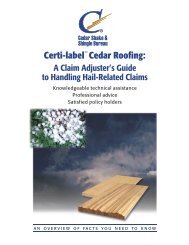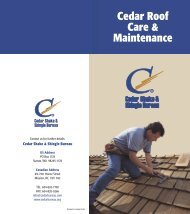New Roof Construction MANUAL - Cedar Shake and Shingle Bureau
New Roof Construction MANUAL - Cedar Shake and Shingle Bureau
New Roof Construction MANUAL - Cedar Shake and Shingle Bureau
Create successful ePaper yourself
Turn your PDF publications into a flip-book with our unique Google optimized e-Paper software.
Certi-label shakes <strong>and</strong> shingles are an<br />
excellent roofing material for cold weather<br />
areas that experience heavy snowfall <strong>and</strong><br />
severe temperature extremes. Certi-label<br />
shakes <strong>and</strong> shingles offer the advantages of<br />
durability, superior wind resistance <strong>and</strong> good<br />
thermal <strong>and</strong> acoustical properties. As with<br />
any other roofing material, however, their<br />
best performance depends upon proper<br />
design, sound construction practice <strong>and</strong><br />
correct installation.<br />
In cold weather areas <strong>and</strong> particularly in<br />
mountain regions that experience very heavy<br />
snowfall, the cold roof - or vented roof<br />
system - is recommended (Figures 20 & 21).<br />
The principle of this system is to allow a<br />
constant flow of cold air above the insulation<br />
but below the roofing material. With other<br />
roofing systems, ice buildup along the eaves<br />
can be a problem. Heat escapes from the<br />
insulation <strong>and</strong> melts snow, which runs down<br />
the roof to the cold overhangs where it<br />
freezes, causing water to back up <strong>and</strong><br />
sometimes penetrate the roof systems. A<br />
properly installed, vented cold roof<br />
eliminates this problem. Venting space<br />
should be sufficient to allow a free flow of air<br />
from eave to ridge.<br />
There are a number of important<br />
considerations that influence roof<br />
performance in areas of heavy snowfall,<br />
particularly mountain regions.<br />
Design, of course, is very important. The<br />
steeper the roof the better the performance.<br />
Chimneys should be located at the ridge or<br />
gable ends away from possible snow<br />
pressure on the slopes. Plumbing pipes<br />
should be located on inside walls <strong>and</strong> should<br />
be extended between the rafters <strong>and</strong> vented<br />
at the ridge. If this is not practical then<br />
plumbing vent pipes should be galvanized<br />
iron, well anchored inside the roof. (Plastic<br />
vent pipes extending through the roof may<br />
be dislodged by sliding snow.)<br />
COLD ROOF SYSTEM DETAILS<br />
Certi-label shakes or shingles<br />
(applied per specification)<br />
Double starter<br />
course<br />
Screen<br />
Vented space<br />
Spaced<br />
sheathing<br />
Rafter<br />
Insulation<br />
Certi-label shakes or shingles<br />
(applied per specification)<br />
Figure 20: Gable <strong>Roof</strong><br />
Decking<br />
Rigid insulation<br />
Vented space<br />
Figure 21: Shed <strong>Roof</strong><br />
Figures 20 & 21: Cold <strong>Roof</strong> Systems<br />
Ridge vent<br />
Cap<br />
Screen<br />
Trim<br />
17<br />
Architect: 3D Building, Photo: David Reeves Studio, Inc.





